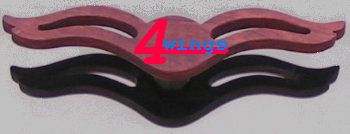| What is Kevlar?
Kevlar is a long-chain synthetic
polyamid, whose particular architecture qualifies it as an "aramid".
Aramid's are close cousins to Nomex, it is used in structural honeycomb
cores, and in fireproof garments worn by race car drivers and rescue
personnel.
Bottom line - Kevlar is tough,
abrasion and puncture resistant.
What is the Mythos
?
Let's get rid of some missleading
aspects ! "Ballistic-grade" Kevlar ( Kevlar-29 ) is very different from
"structural-grade" Kevlar ( Kevlar-49 ). Kevlar-29 is not a laminate -
but multi-layer soft "blankets" of Kevlar plies sewn together - known
as "soft armor" - and then mechanically fastened to the "what so ever "
work piece - not very useful in our Hovercraft ! So if some
Hovercraft's / Boats have Kevlar components and get advertised as
bulletproof - just walk away - it is just a mythos - but not the
fact .
Sorry if I killed somebody's
advertising slogan .
Design and
Application !
A big advantage is Kevlar's
specific gravity of 1.5 in relation to E-glass with about 2.4 that
allows you to produce a lighter work piece - on the other hand -
there is the problem that E-glass will sink easier in the resin than
Kevlar and it is most important to apply extra care while wetting out
and getting rid of excess resin - either by hand with squeegee's or
with the application of Peel Ply!
But the first step is still to cut dry Kevlar !What
is easy on E-glass - since you break the fibers more than cutting them
is hard on Kevlar - Sharp tools are critical to successfully cutting
Kevlar.Don't use the same tool for cutting Kevlar and E-glass since the
E-glass will quickly kill the tool edge reducing its effectiveness in
cutting the Kevlar fibers. If you have troubles cutting the
fabric with your shears or get a very fuzzy edge - you can try to apply
3M blue masking tape on both sides of the cloth - lay it on a piece of
hardwood , use a metal ruler and cut with a razor blade through the
tape and the cloth - normally you will achieve good results for about 2
feet before you have to change the razor blade.
Resins which are very suitable for E-glass applications might
not work well with Kevlar - you need lower viscosity epoxy resins to
get the most out of your work piece. It is recommended to use Epoxies
with viscosity's under 300 centipoints - in relation "general -
purpose" styrenated laminating resins are 800 centipoints or above !
Keep in mind that the biggest downside of Kevlar is its
compression strength ( about 30% less than plain old E-glass) -
but in the lift - thrust duct it would give great safety. Watch
out for the cloth floating on your resin ( especially in corners or
edges where you laminate in a L or U shape ) the resin will have the
tendency to seep down and lift the Kevlar cloth on these locations ...
if possible avoid a solid cloth and lay one at the bottom and when
cured a second strip over the edge from the top down to reduce resin
pockets.
Safety - Although Kevlar dust and fibers won't make you
itch like E-glass does, inhaling yellow fuzz simply isn't a smart idea.
Wear suitable respiratory protection and a good fitting set of safety
glasses or goggles. Even your nose and lungs won't know if you're
laminating Kevlar or last weeks newspaper, a good respirator and
adequate shop air-exchange rates obviously are recommended during
cutting, wet-layup and finishing work!
Grinding - Sanding of the work piece is some headache since grits much
coarser than 180 really "fuzz up " Kevlar - which is no big deal in
case of a repair since the fibers mingle nicely with the patch and
increase adhesion - just for the finishing up, you have to sand with
180 - 200 grit to reduce fuzing and last not least make a finish with
ScotchBrite. Better even is if your Kevlar cloth is still
covered by a thin layer of Fiberglass cloth as such you won't sand into
it.
Cutting, boring and
machining is the best way to
call 1-800-4-KEVLAR and ask for DuPont's product literature - and make
use of the recommendations for tool vendors since it would take me 6
month to get all their links here together! Just for the moment to
satisfy you : Basic rule of thumb for almost all cutting,
machining, and boring operations on Kevlar laminates is high speed, low feed!
Backing up the area which is
machined is important to avoid delamination. As well as keeping a eye
on the workpiece temperature - Resins change their physical propperties
above 180 F.
4wings Main page - 4wings Yachtservice - Kite-sailer.com - Site-map
|

